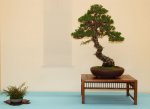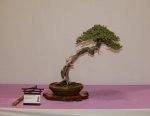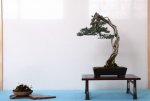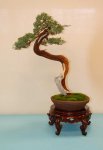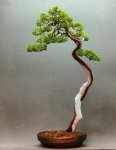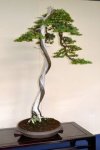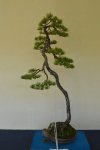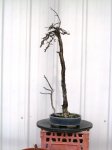Smoke
Ignore-Amus
From Art of Bonsai:
Traditionally Literati bonsai have trunks that twist and turn in multiple, often dramatic curves, usually have slender trunks which have no lower branches to speak of, and have an obvious lack of Nebari in most cases. Closer to an informal upright than any other style, it escapes from classification as such because of the lack of Nebari and lower branches. But there is something else, the foliage of a Literati often is purposely sparse, just enough to sustain the tree and keep it healthy. John Naka once said of this style, "It is a dream, an abstract. It is an extremely advanced, significant bonsai design." These words of John's capture the essence of the Literati Style Bonsai.
John Naka wrote an article titled, "Characteristics of Bunjin Style" which was published in the Golden Statements Magazine (March/April 1993) and quoted recently by Eric Schrader at the Bonsai Society of San Francisco's web site. In this article about Literati, John made some other interesting definitions of the style, some of which are listed below.
My question is what is too heavy for literati? In the paragraph from Art of Bonsai we read "slender trunks".
Slender compared to what? Do we have a mental model of what a Literati is supposed to be? Is it based on trees seen in a exhibit or pictures from the internet? I use the word "mental model" because in many cases, the name of a bonsai form seems to mean different things to different people. We could call this a sub conscience feeling of a certain tree you may have seen that moved you and your mind has developed a mental model for that tree within that form and compares every tree you see to that image. Every time you see a tree at an exhibit, your mind is comparing the tree you see to the mental model of the one tree that has moved you.
What each artist must do is make a tree better than your previous mental model and replace that with the old image. For me, Literati is more about a feeling than anything else. I must be moved in some way to decide if the tree I'm looking at has filled the bill on basic requirements of the Literati feeling. The height, nor size of the trunk contributes to that feeling. It's like porn, I know it when I see it. For me there is no "sort of" Literati. It either hits the mark or does not.
In comparing these two trees, one has a rather heavy trunk and one has a very slender trunk.
Slender trunk

Heavy trunk
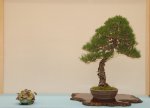
While both of these trees make me feel Literati, I feel that the canopies are still mush too heavy for a good representation of Literati. I would need much more sparseness.
Traditionally Literati bonsai have trunks that twist and turn in multiple, often dramatic curves, usually have slender trunks which have no lower branches to speak of, and have an obvious lack of Nebari in most cases. Closer to an informal upright than any other style, it escapes from classification as such because of the lack of Nebari and lower branches. But there is something else, the foliage of a Literati often is purposely sparse, just enough to sustain the tree and keep it healthy. John Naka once said of this style, "It is a dream, an abstract. It is an extremely advanced, significant bonsai design." These words of John's capture the essence of the Literati Style Bonsai.
John Naka wrote an article titled, "Characteristics of Bunjin Style" which was published in the Golden Statements Magazine (March/April 1993) and quoted recently by Eric Schrader at the Bonsai Society of San Francisco's web site. In this article about Literati, John made some other interesting definitions of the style, some of which are listed below.
- It has shape or form but there is no definite pattern.
- It has no pattern, it is irregular and seems disfigured.
- It is like food that has no taste at the beginning but the more you chew the more flavor comes out. When you first look at Bunjin style there is nothing exciting about it, it is so skimpy and lonely. But the more you observe it the more the tree quality and natural traits will come out. You will feel something from inside of your mind, and not only through the surface eyes.
- It looks like it is struggling for its survival, or a form of agony. The tree itself should not be in this condition, in reality it should be healthy. The shape or form may indicate struggle but not health. It seems to be a very cruel method but it is only concept. Its appearance should not be too serious nor easy, it should be free, unconstrained, witty, clever, humorous and unconventional. A good example for this is a study of any of nature's tree that has survived some sort of problem or disaster.
- To avoid uselessness, the ultimate final form or shape is a very important technique.
- It should portray a simple abstract painting, Senryu, Haiku, poem, music and song.
- Shape or form is from wind, weather, not too rugged but more graceful.
Seems to me like you may just be ready to move on from this one. I don't see a literati here, so option 2 is what you have. Maybe time to sell it and let someone else have a go.
OK, I can go for that image. Seems a bit heavy for literati, we should call it Al-literati. An alliteration if you must...

My question is what is too heavy for literati? In the paragraph from Art of Bonsai we read "slender trunks".
Slender compared to what? Do we have a mental model of what a Literati is supposed to be? Is it based on trees seen in a exhibit or pictures from the internet? I use the word "mental model" because in many cases, the name of a bonsai form seems to mean different things to different people. We could call this a sub conscience feeling of a certain tree you may have seen that moved you and your mind has developed a mental model for that tree within that form and compares every tree you see to that image. Every time you see a tree at an exhibit, your mind is comparing the tree you see to the mental model of the one tree that has moved you.
What each artist must do is make a tree better than your previous mental model and replace that with the old image. For me, Literati is more about a feeling than anything else. I must be moved in some way to decide if the tree I'm looking at has filled the bill on basic requirements of the Literati feeling. The height, nor size of the trunk contributes to that feeling. It's like porn, I know it when I see it. For me there is no "sort of" Literati. It either hits the mark or does not.
In comparing these two trees, one has a rather heavy trunk and one has a very slender trunk.
Slender trunk

Heavy trunk

While both of these trees make me feel Literati, I feel that the canopies are still mush too heavy for a good representation of Literati. I would need much more sparseness.
Last edited:


